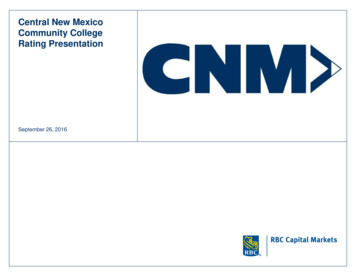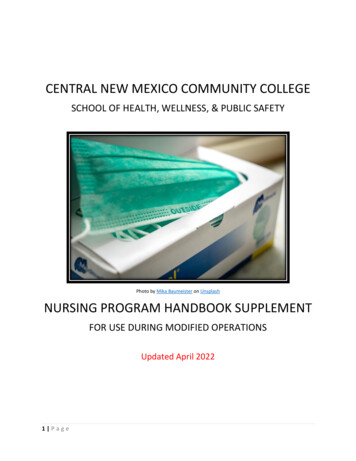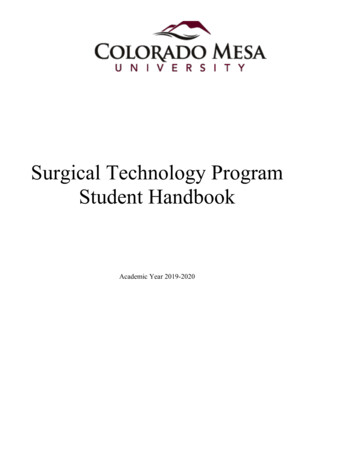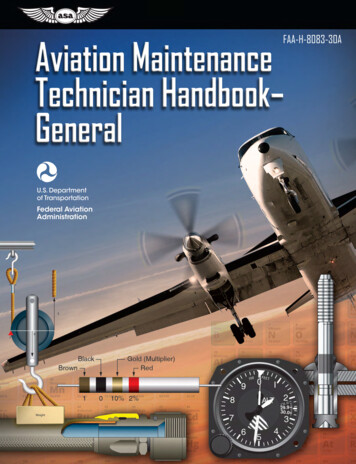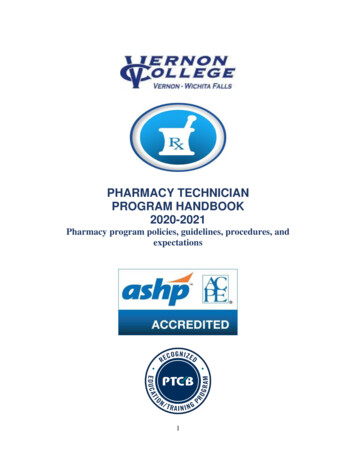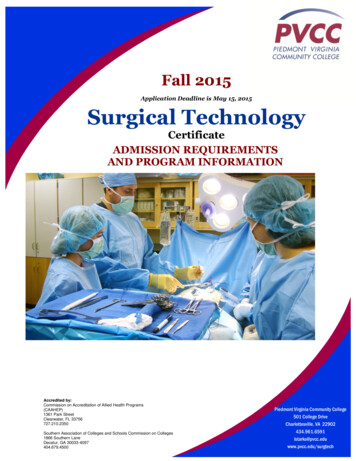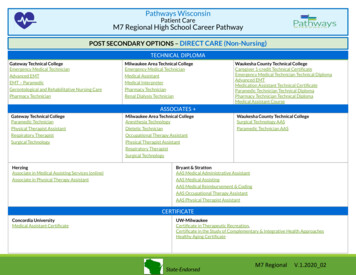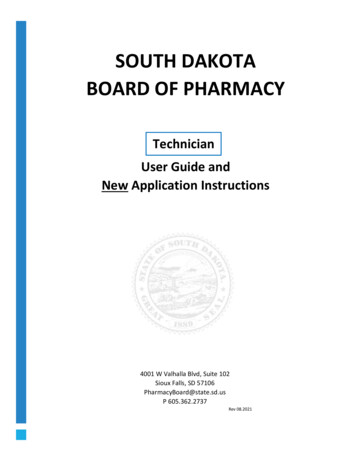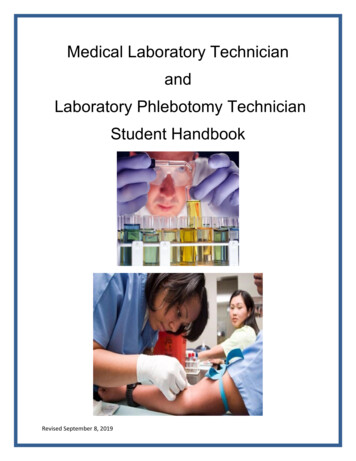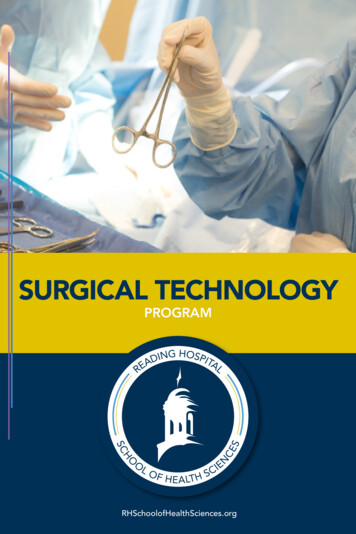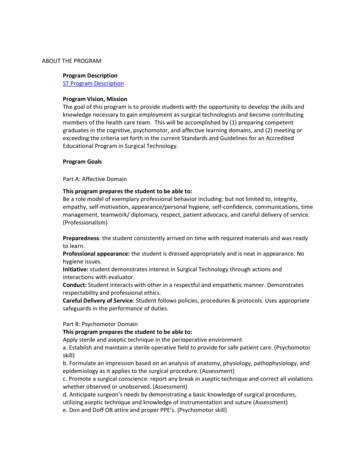
Transcription
ABOUT THE PROGRAMProgram DescriptionST Program DescriptionProgram Vision, MissionThe goal of this program is to provide students with the opportunity to develop the skills andknowledge necessary to gain employment as surgical technologists and become contributingmembers of the health care team. This will be accomplished by (1) preparing competentgraduates in the cognitive, psychomotor, and affective learning domains, and (2) meeting orexceeding the criteria set forth in the current Standards and Guidelines for an AccreditedEducational Program in Surgical Technology.Program GoalsPart A: Affective DomainThis program prepares the student to be able to:Be a role model of exemplary professional behavior including: but not limited to, integrity,empathy, self-motivation, appearance/personal hygiene, self-confidence, communications, timemanagement, teamwork/ diplomacy, respect, patient advocacy, and careful delivery of service.(Professionalism)Preparedness: the student consistently arrived on time with required materials and was readyto learn.Professional appearance: the student is dressed appropriately and is neat in appearance. Nohygiene issues.Initiative: student demonstrates interest in Surgical Technology through actions andinteractions with evaluator.Conduct: Student interacts with other in a respectful and empathetic manner. Demonstratesrespectability and professional ethics.Careful Delivery of Service: Student follows policies, procedures & protocols. Uses appropriatesafeguards in the performance of duties.Part B: Psychomotor DomainThis program prepares the student to be able to:Apply sterile and aseptic technique in the perioperative environmenta. Establish and maintain a sterile operative field to provide for safe patient care. (Psychomotorskill)b. Formulate an impression based on an analysis of anatomy, physiology, pathophysiology, andepidemiology as it applies to the surgical procedure. (Assessment)c. Promote a surgical conscience: report any break in aseptic technique and correct all violationswhether observed or unobserved. (Assessment)d. Anticipate surgeon’s needs by demonstrating a basic knowledge of surgical procedures,utilizing aseptic technique and knowledge of instrumentation and suture (Assessment)e. Don and Doff OR attire and proper PPE’s. (Psychomotor skill)
f. Count sponges, sharps and instruments according to facility policy (Psychomotor skill)g. Follow Safety policies and procedures (sharps, electrosurgical, positioning) according tofacility policy (assessment)h. Label and announcing medications and fluids (Psychomotor skill)i. Participate in Universal Protocol (assessment)Safely and effectively perform all psychomotor skills within the Association of SurgicalTechnology Standard of Practice Model. (Psychomotor Skills)f. Student demonstrates proficiency in skills performed.Part C: Cognitive DomainThis course prepares the student to be able to:Perform Surgical Technology entry-level decision making in the content areas of:(a) Pre-operative, intra-operative, and post-operative(b) Disinfection, sterilization, and processing of surgical instruments(c) General Surgery, OB/GYN Surgery, Ophthalmic Surgery, Otorhinolaryngologic Surgery, Oraland Maxillofacial Surgery, Plastic and Reconstructive Surgery, Genitourinary Surgery, OrthopedicSurgery, Cardiothoracic Surgery, Peripheral Vascular Surgery, Neurosurgical Proceduresa. Anticipate surgeon’s needs to promote a positive surgical outcome. (Decision Making)b. Perform tasks as part of a surgical interventions intended to mitigate a positive patientoutcome. (Decision Making)c. Evaluate the effectiveness of their performance and modifies actions accordingly. (DecisionMaking)d. Knowledge: the student can recall common terms, facts, principles and basic concepts inSurgical Technology.e. Problem Solving: the student uses knowledge to solve a previously encountered situation.f. Evaluation: the student can judge the appropriateness of actions and can defend his/herdecisions.g. Meet or Exceed the Accreditation Review Council of Surgical Technology and SurgicalAssisting Education Standard: Scrubbed cases ( 120 first and second scrubbed cases); Retention( 70%)h. Meet or Exceed the Accreditation Review Council of Surgical Technology and SurgicalAssisting Education Standard: CST Exam 70% Grads Passingi. CNM Standard: Retention ( 75%)j. ST Program Standards:Student success ( 70% C-pass rate of students who were enrolled in the class at census andremain on last day)Course Final pass rate ( 80% of students score 70% or better on written final exam)Program OfficialsAmy Rademacher-Neel, Program DirectorCaroline Geissler, Clinical CoordinatorProgram FacultyAmy Rademacher-Neel, Program Director/FT FacultyCaroline Geissler, Clinical Coordinator/FT FacultyHolly Erickson, PT FacultyClaudia Cafferky, PT Faculty
Kara, Perea, PT FacultyChristine Dolphin, PT FacultyZach Strickler, PT FacultyVictoria Boykin, PT FacultyOrganizational Framework (if applicable)AccreditationCAAHEPAdvisory BoardMembership meets twice a year and includes:EmployersPracticing PhysicianCSTCurrent StudentFormer StudentPublic RepresentativeFaculty and administration from HWPSJob Connection CenterProgram Curriculum and course descriptionsTerm by TermProgram Competency ExpectationsO*NETExit CompetenciesUpon Completion of this Program, students will be able to:1.2.Comprehend and apply sterile and aseptic technique in the perioperative environment. These skillsinclude: establish and maintain a sterile operative field to provide for safe patient care promote a surgical conscience: report any break in aseptic technique and correct all violationswhether observed or unobserved anticipate surgeon’s needs by utilizing aseptic technique and knowledge of instrumentation andsuture demonstrate a basic knowledge of surgical proceduresPerform a variety of supportive clinical skills. These skills include the ability to follow and verbalizeestablished hospital/surgical environment’s safety policies and procedures for: OR attire and proper PPE’s counting sponges, sharps, and instruments sharps safety positioning safety labeling and announcing medications and fluids Universal Protocol electrosurgical safety
3.4.5.Exhibit behaviors consistent with professional and employer expectations. These behaviors will helpthe student to be successful in securing and maintain a career in the profession of surgicaltechnology. They will include: punctuality teamwork appropriate interaction with patients of all ages and backgrounds respect to personal beliefs without discrimination of patient care communicate effectively and work cooperatively with supervisor, co-workers and surgical teamin preoperative, intraoperative and postoperative care of the surgical patient provide for patient privacy, and maintain patient confidentiality.Perform disinfection, sterilization, and processing of surgical instruments. These skills will include: cleaning of instruments during the surgical procedure containment and transportation to the decontamination room using proper cleaning agents and methods to effectively clean instruments visually inspecting instruments prior to sterilization; assembling, packaging, sterilization, and distribution of instrumentationProfession participation and development: Students should be committed to the perioperativeprofession by participation in professional organizations and educational workshops while enrolled inthe program. Obtaining certification as a professional by taking the national Surgical TechnologyCertification (CST) exam upon the completion of the program.Code of Ethics for DisciplineStudents are expected to adhere to the Association of Surgical Technologists Code of Ethics. The Codeof Ethics includes the following:1. To maintain the highest standards of professional conduct and patient care.2. To hold in confidence, with respect to the patient’s beliefs, all personal matters.3. To respect and protect the patient’s legal and moral rights to quality patient care.4. To not knowingly cause injury or any injustice to those entrusted to our care.5. To work with fellow technologists and other professional health groups to promote harmony and unityfor better patient care.6. To always follow the principles of asepsis.7. To maintain a high degree of efficiency through continuing education.8. To maintain and practice surgical technology willingly, with pride and dignity.9. To report any unethical conduct or practice to the proper authority.10. To adhere to the Code of Ethics at all times in relationship to all members of the health care team.Student Work PolicyAll student activities associated with the curriculum, especially while students are completing clinicalrotations, will be educational in nature. Students will not be substituted for hired staff personnel withinthe clinical institution, in the capacity of a surgical technologist.UniformsStudents must wear Caribbean Blue scrubs (no cargo pants) with CNM ST patch to theory, lab,and clinical courses. Shoes must be closed toe and worn with socks.Functional Abilities for Program StudentsO*NETProgram completionStudents must sit for the CST exam in order to graduate from the program.
Program CommunicationFaculty hold regularly scheduled office hours that are published in the syllabus.Program Director: 505-224-4000 ext. 50187Clinical Coordinator: 505-224-4000 ext. 50556CLINICAL POLICIESClinical Affiliates, Locations, and AddressesUNM Hospital-MOR 2211 Lomas Blvd Albuquerque, NM 87106UNM Hospital-BBRP 2211 Lomas Blvd Albuquerque, NM 87106UNM Hospital-OSIS 1215 University Blvd Albuquerque, NM 87106UNM Hospital L& D 2211 Lomas Blvd Albuquerque, NM 87106Lovelace Medical Center 601 Dr. MLK Blvd, NE, Albuquerque, NM 87102Lovelace Women’s Hospital 4701 Montgomery Blvd. NW, Albuquerque, NM 87109Lovelace Westside Hospital 10510 Golf Course Rd. NW, Albuquerque, NM 87114Presbyterian Hospital-MOR 1100 Central Ave SE, Albuquerque, NM 87106Rust Medical Center 2400 Unser Blvd SE, Rio Rancho, NM 87124VA Hospital (NMVAHCS) 1501 San Pedro Ave SE, Albuquerque, NM 87108Socorro General Hospital 1202 Highway 60 West, Socorro, NM 87801Sandoval Regional Medical Center 3100 Broadmoor Blvd NE, Rio Rancho, NM 87144Christus St. Vincent Regional Medical Center 455 St Michaels Dr, Santa Fe, NM 87505Clinical schedulingStudents must complete 24 hours of clinical per week. Shifts may vary to include day, evening,swing and weekend. Clinical assignment is based on student skill level and not on convenienceof location. Students may be assigned to a clinical site located outside of the Albuquerque area.Refusal of a clinical assignment may result in the inability to complete the course. Studentsmust provide their own transportation to clinical sites.Schedule Change Requests N/AClinical EvaluationStudent performance is evaluated by faculty and hospital staff. Failure to attain anddemonstrate essential skills appropriate to the site may result in the removal of a student froma site and, possibly, the course. Being removed from a site does not guarantee placement at adifferent site.Clinical Attendance/Absences/Call off policyExcessive absences in a course is missing more than two (2) days of lab, or clinical per term. Studentsmissing more than two days are unable to meet course objectives and must participate in a success planin order to continue the program.SURGICAL ROTATION CASE REQUIREMENTSAs set by the Core Curriculum for Surgical Technology 6th edition
Surgical SpecialtyGeneral SurgeryTotal # ofCasesRequiredMinimum # ofFirst ScrubCasesRequiredMaximum # ofSecond ScrubCases that canbe appliedTowards 120Cases3022021090360330Surgical Specialties: lOrthopedicsPeripheral vascularPlasticsProcurement/Transplant10 diagnosticendoscopycases may beapplied towardthe secondscrub cases.5Diagnostic Endoscopy: Bronchoscopy Colonoscopy Cystocopy EGD ERCP Esophagoscopy Laryngoscopy Panendoscopy Sinoscopy UreteroscopyLabor and DeliveryTotals5 vaginaldelivery casesmay be appliedtowards thesecond scrubcases. 51208040
A. General Surgery casesStudents must complete a minimum of 120 cases as delineated below.1. Students must complete a minimum of 30 cases in General Surgery; 20 which must beperformed in the First Scrub Role. The remaining 10 cases may be performed in either theFirst or Second Scrub Role.B. Specialty cases1. Students must complete a minimum of 90 cases in various surgical specialties, excludingGeneral Surgery; 60 which must be performed in the First Scrub Role. The additional 30cases may be performed in either the First or Second Scrub Role.a. A minimum of 60 surgical specialty cases must be performed in the First Scrub Role anddistributed amongst a minimum of four surgical specialties.(1) A minimum of 10 cases in the First Scrub Role must be completed in each of the requiredminimum of four surgical specialties (40 cases total required).(2) The additional 20 cases in the First Scrub Role may be distributed amongst any onesurgical specialty or multiple surgical specialties.b. The remaining 30 surgical specialty cases may be performed in any surgical specialtyeither in the First or Second Scrub Role.C. Optional surgical specialties1. Diagnostic endoscopy cases and vaginal delivery cases are not mandatory. However, up to10 diagnostic endoscopic cases and 5 vaginal delivery cases can be counted toward themaximum number of Second Scrub Role cases.a. Diagnostic endoscopy cases must be documented in the category of “DiagnosticEndoscopy”, rather than by specialty.b. Vaginal delivery cases must be documented in the category of “Labor & Delivery” ratherthan in the OB/GYN specialty.D. Case experience in the Second Scrub Role is not mandatory.E. Observation cases must be documented, but do not count towards the 120 required cases.F. Counting cases1. Cases will be counted and documented according to surgical specialty (exception beingdiagnostic endoscopic cases; refer to II. C.1.a. above).2. Examples of counting casesa. Trauma patient requires a splenectomy and repair of a Lefort I fracture. Two cases can becounted and documented since the splenectomy is general surgery specialty and repair ofLeFort I is oral-maxillofacial surgical specialty.b. Patient requires a breast biopsy followed by mastectomy. It is one pathology, breastcancer, and the specialty is general surgery; therefore, it is counted and documented as oneprocedure – one case.c. Endoscopic cases that convert to an open case (e.g.: Laparoscopic Cholecystectomyconverted to an Open Cholecystectomy) are counted and documented as one (1) procedure—one case.
minimum of four surgical specialties (40 cases total required). (2) The additional 20 cases in the First Scrub Role may be distributed amongst any one surgical specialty or multiple surgical specialties. b. The remaining 30 surgical specialty cases may be performed in any surgical specialty either in the First or Second Scrub Role.
